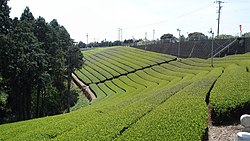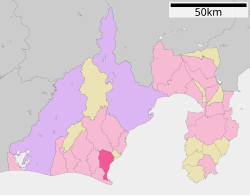Makinohara, Shizuoka
|
Makinohara 牧之原市 |
|||
|---|---|---|---|
| City | |||

Tea plantations in Makinohara
|
|||
|
|||
 Location of Makinohara in Shizuoka Prefecture |
|||
| Coordinates: 34°44′N 138°13′E / 34.733°N 138.217°ECoordinates: 34°44′N 138°13′E / 34.733°N 138.217°E | |||
| Country | Japan | ||
| Region | Chūbu (Tōkai) | ||
| Prefecture | Shizuoka Prefecture | ||
| Government | |||
| • Mayor | Shigeki Nishihara | ||
| Area | |||
| • Total | 111.68 km2 (43.12 sq mi) | ||
| Population (September 2014) | |||
| • Total | 46,040 | ||
| • Density | 412/km2 (1,070/sq mi) | ||
| Time zone | Japan Standard Time (UTC+9) | ||
| - Tree | camellia sinensis | ||
| - Flower | hydrangea | ||
| Phone number | 548-23-0001 | ||
| Address | 447 Shizunami, Makinohara-shi, Shizuoka-ken 421-0495 | ||
| Website | www |
||
Makinohara (牧之原市 Makinohara-shi?) is a city located in western Shizuoka Prefecture, Japan.
As of September 2014, the city had an estimated population of 46,040 and a population density of 412 persons per km². The total area was 111.68 km².
Makinohara is located in south-central Shizuoka Prefecture. It is bordered by Suruga Bay on the Pacific Ocean to the east, and rises gradually to the Makinohara Plateau in the west. The area has a temperate maritime climate, characterized by hot, humid summers and mild winters, with the warm Kuroshio Current offshort providing a moderating effect.
The area of present-day Makinohara was part of former Tōtōmi Province. During the Edo period, the town of Sagara was the center of Sagara Domain. In the cadastral reform of the early Meiji period on April 1, 1889, the area Sagara incorporated as a town within Haibara District.
The modern city of Makinohara was established on October 11, 2005, from the merger of the towns of Haibara and Sagara (both from Haibara District).
The local economy of Makinohara is dominated by the production of green tea, and to a lesser extent by fishing, and manufacturing of automobile components for Suzuki.
...
Wikipedia



